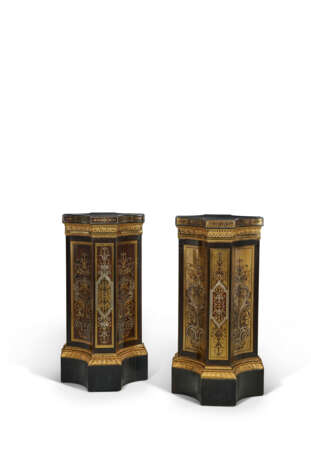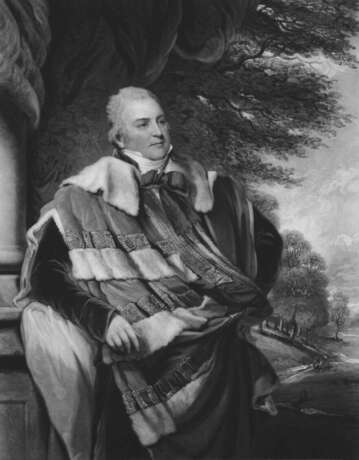ID 1329889
Los 7 | PAIRE DE PIÉDESTAUX D'ÉPOQUE LOUIS XIV
Schätzwert
€ 200 000 – 400 000
ATTRIBUÉE À ANDRÉ-CHARLES BOULLE, VERS 1715
En ébène, marqueterie Boulle de première partie et contre partie d'écaille de tortue à écailles imbriquées et Caouanne, et filet de laiton et étain toute face et ornementation de bronze ciselé et doré, de forme rectangulaire à pans concaves, la partie supérieure ceinte d'une frise d'acanthe surmontant des enroulements cordiformes noués de guirlandes de feuilles, les panneaux à motifs de rinceaux feuillagés, de larges enroulements de fleurs et de réserves, la base en plinte appliquée d'une frise d'oves sur des canaux ; restauration, à l'origine ouvrant chacune par une porte
H. 107 cm. (41 1/3 in.) ; L. 56 cm. (22 in.) ; P. 52 cm. (20 ½ in.)
Provenance
George Capell-Coningsby, 5th Earl of Essex (1757-1839), Cassiobury Park, Hertfordshire; sa vente, Christie’s Londres, 12 mai 1893, une suite de quatre sous les lots 101 et 102.
Une paire; collection de Gaby Salomon, Buenos Aires; sa vente Christie's, Londres, 2 décembre 1971, lot 77 ;Vente, Sotheby's Londres, 25 juin 1982, lot 163. Importante collection privée française.
Literature
Bibliographie comparative :
Connaissance des arts, le XVIIe siècle français, Paris, 1958, p. 69, pl. 4.
T. Dell, The Frick Collection, an illustrated catalogue, t. V, Furniture Italian & French, Lunenburg, 1992, pp. 214-223.
G. Wilson, Baroque and Régence, catalogue of the J. Paul Getty Museum Collection, Los Angeles, 2008, n. 22, pp. 226-235.
Cat. Expo, André Charles Boulle 1642-1732, un nouveau style pour l’Europe, sous la dir. De J. N. Ronfort, Museum für Angewandte Kunst, Francfort, 30 octobre 2009 – 31 janvier 2010, p. 69.
C. Demetrescu, Les ébénistes de la Couronne sous le règne de Louis XIV, Lausanne, 2021, p. 194.
Cat. Expo, André Charles Boulle, sous la dir. de M. Deldicque, Musée Condé - château de Chantilly, 8 juin - 6 octobre 2024, n. 17, pp. 144-153.
Further details
A PAIR OF LOUIS XIV ORMOLU-MOUNTED TORTOISESHELL, BRASS AND PEWTER INLAID BOULLE MARQUETRY AND EBONY PEDESTALS, ATTRIBUTED TO ANDRE-CHARLES BOULLE, CIRCA 1715
This pair of pedestals attributed to André-Charles Boulle is characterised by a bold and uncommon shape, showcasing the creativity and brilliance of the cabinetmaker through a rare model that combines technical mastery with elegance.
A rare corpus
This pair belongs to a select corpus of innovative works, initiated by the initial commissions of the Grand Dauphin for Versailles. The Grand Dauphin (1661–1711), son of Louis XIV, had a natural inclination toward the fine arts and exquisite furniture. It was only fitting that he should turn to acclaimed cabinetmaker André-Charles Boulle (1642–1732) to furnish his interiors with original designs and exclusive pieces.
In 1686 he commissioned a pair of pedestals, later described in the inventory of his collections as two large eight-sided pedestals, four hollow and four plain veneered with tortoiseshell and copper leaves, embellished with gilt copper chased mouldings, topped with a four-sided carpet with chutes and a lapis-coloured background […], and the model was born.
Passed through several collections belonging to dealers and private individuals during the 18th and 19th centuries, these pedestals are now preserved in Chaalis as part of the former collections of Nélie Jacquemart-André and were on display at the latest retrospective exhibition of Boulle’s work held at the Château de Chantilly in the autumn of 2024 (cat. Exhib, André-Charles Boulle, under the direction of M. Deldicque, château of Chantilly, 8 June-6 October 2024, n. 17, pp 144–153. ; Inv. MJAC – M 945 – 1/2).
The Chaalis pedestals, ancestors of a limited series, represent a significant milestone in the history of Boulle furniture, allowing us to understand and place the pair presented here within the context of Boulle’s oeuvre. All of these pedestals constitute a rare ensemble; despite their design being rather successful, the complexity of their construction limited the number of pieces produced. Each pedestal involved meticulous marquetry combining tortoiseshell, brass and delicately chased gilt bronzes, in which Boulle excelled. This corpus preserves subtle decorative variations, while remaining true to the shape initiated with the commission for the Grand Dauphin.
Let us mention that a pair is preserved in the Frick collection (Inv. 16.5.6 – 16.5.7). Here the marquetry on the concave sides is devoid of lapis aprons; however, the design echoes the characteristic oblong shape of the upper section. The originality here is that the cut sections feature a first part and a corresponding counterpart on the same panel. Another pair of the same model is housed in the Getty Museum (Inv 88.DA.75.1-2.). Originating from the private office of Alexandre Dubois (sale on 18 December 1788 under no. 168), where it was sold to one ‘Berotaire’, it subsequently entered the Barons’ Rothschild collections throughout the 19th century before finally being sold to the museum at Couturier Nicolay on 4 December 1987 under lot 112. This counterpart pair is possibly a sister pair to a first part pair sold at Sotheby’s on 31 October 1987 in New York. These likely came from the collection of Chevalier Féréol Bonnemaison, before belonging to the collections of the Duke of Hamilton (Christie’s sale, 8 July 1882, lot 1280), and being acquired by one F. Davis for £1,680 and finally finding their way into the collections of Lord Hillingdon.
19th century provenance
Our present lot can be traced back to the 19th century. They appeared in 1893 at the sale of the collection of George Capell-Coningsby, 5th Earl of Essex, at Christie’s in London on 12 May, listed under lots 101 or 102. They were in fact part of a set of four. It is also noteworthy that, according to the illustration in this catalogue, our pedestals included a lock on one of the cut sides, suggesting that they could originally have been opened, similarly to the other models already mentioned.
The history of our pedestals is subsequently more difficult to verify, as both pairs presented at the Earl of Essex’s sale appear to be perfectly identical. Consequently, either our lot or its pair would eventually find its way into the collection of Mrs Gaby Salomon of Buenos Aires and be sold as Lot 77 at Christie’s London sale on 2 December 1971. A few years later, they reappeared as lot 163 at a Sotheby’s sale in London on 25 June 1982, where they were described as belonging to the Louis XVI period.
André-Charles Boulle, the undisputed master of marquetry
André-Charles was born on 10 November 1642; his talent for drawing, engraving, chiselling and painting was quickly recognised. He received the title of master cabinetmaker before 1666. To announce the works of Boulle is to cite furniture of the most exquisite shapes and unparalleled richness… nothing to date has surpassed this type of craftsmanship… We know the splendour he brings to curiosity cabinets, and for which he invariably ranks among the best.
Over two centuries on, these words by the renowned art dealer Jean-Baptiste Lebrun (1748–1813) about André-Charles Boulle are still as relevant as ever. Retracing Boulle’s career involves recalling that, under the royal privilege of being the King’s ordinary cabinetmaker and marker, granted to him by the Queen on 20 May 1672 together with his lodging in the galleries of the Louvre, he was entitled to produce both cabinetry and bronzes in his workshop for the remainder of his life, despite corporate rules. Boulle’s workshop was extensive, and despite being granted lodgings in the Louvre in May 1672, most of it remained on the Left Bank, only to be extended to two further houses on rue de Reims from 1673 to 1676. It would not be until the following year that Boulle would permanently establish his workshop on three floors of the main building in the Louvre – now the Victory of Samothrace staircase – alongside his accommodation in the Grande Galerie, which was further extended by two floors in 1679. This twofold privilege allowed him to showcase his many talents, whether in terms of techniques or in creating new shapes, as evidenced by our current lot.
His customers were prestigious, and included the Bâtiments du roi (King’s Buildings), the Queen, the Grand Dauphin, as already mentioned, and also the Duchess of Burgundy. André-Charles Boulle’s clientele was not exclusively royal, however, encompassing numerous financiers, ministers and senior civil servants; among them were: Antoine Crozat (1655–1738), Pierre Thomé (1649–1710), Moulle (died 1702), the minister Louvois (died 1693), Moyse-Augustin de Fontanieu (died 1725) intendant of the Garde-Meuble Royal after 1711, and the Cardinal of Rohan (1674–1749).
| Adresse der Versteigerung |
CHRISTIE'S 9 Avenue Matignon 75008 Paris Frankreich | ||||||||||||||
|---|---|---|---|---|---|---|---|---|---|---|---|---|---|---|---|
| Vorschau |
| ||||||||||||||
| Telefon | +33 (0)1 40 76 85 85 | ||||||||||||||
| Fax | +33 (0)1 40 76 85 86 | ||||||||||||||
| Nutzungsbedingungen | Nutzungsbedingungen | ||||||||||||||
| Versand |
Postdienst Kurierdienst Selbstabholung | ||||||||||||||
| Zahlungsarten |
Banküberweisung | ||||||||||||||
| Geschäftszeiten | Geschäftszeiten
|










